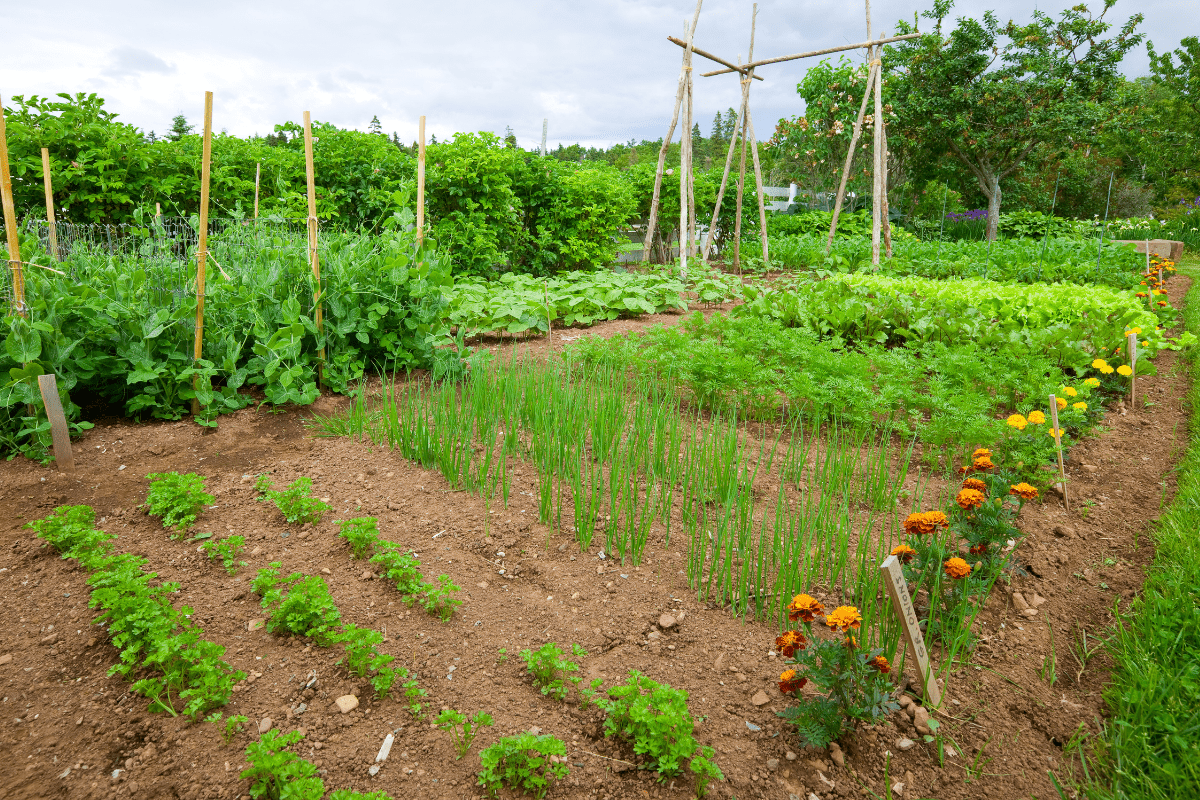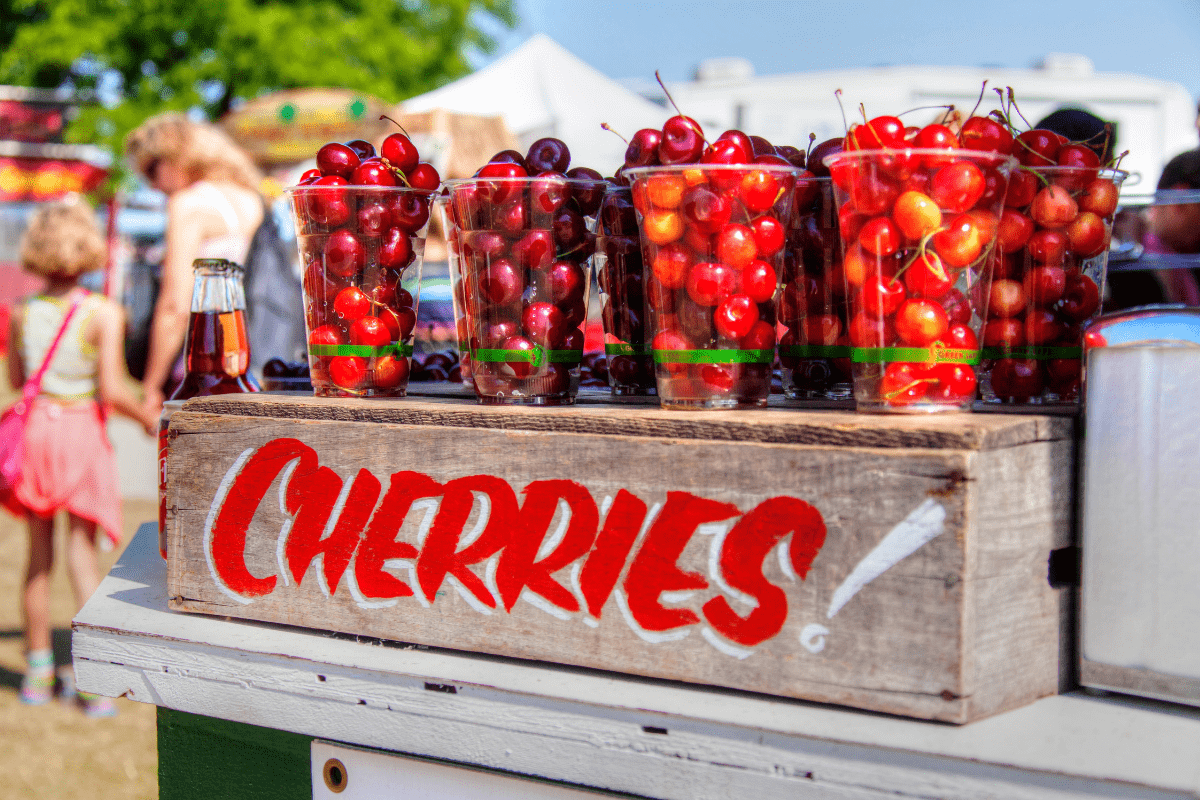Never miss Michigan's peak strawberry season again. From June's ruby-red berries to October's crisp apples, this guide reveals exactly when to find your favorite local produce and where to get it. Michigan grows over 300 agricultural commodities…second only to California in diversity…yet many residents struggle to know what's fresh right now.
Whether you're planning your garden or heading to the farmers market, understanding Michigan's unique growing seasons transforms how you eat, shop, and preserve local bounty year-round. The state's position between the Great Lakes creates remarkable agricultural diversity. USDA zones range from 3a in the Upper Peninsula to 6b near Detroit, with lake-effect microclimates extending growing seasons along the shorelines. This geographic advantage means Michiganders can enjoy fresh asparagus in April, peak blueberries in July, and stored root vegetables through winter…if you know when and where to look.
Spring awakens with asparagus and rhubarb
Michigan's growing season begins while snow still lingers in shaded corners. By late March, commercial asparagus fields show their first green spears, marking the unofficial start of farmers market season. Asparagus peaks from mid-April through May, with Michigan leading the nation in production. Smart shoppers arrive at markets early…the tender spears sell out fast.
April brings the first harvest of cool-season crops. Spinach, lettuce, radishes, and peas thrive in Michigan's variable spring weather. Rebecca Krans and Sarah Rautio, MSU Extension's consumer horticulture educators, advise home gardeners to "plant pea and kale seeds, onion sets, and seed potatoes as soon as you can work the soil." The key is patience…Michigan's last frost typically occurs between May 1-15, though northern areas may see frost into early June.
Rhubarb emerges alongside asparagus, its tart stalks perfect for pies and preserves. By mid-May, strawberry plants begin flowering, promising June's sweet harvest. Spring flowers paint Michigan landscapes: daffodils and tulips bloom in succession, while native wildflowers like trillium and bloodroot carpet forest floors. The state's famous fruit tree blossoms…cherry, apple, and pear…peak in mid to late May, creating spectacular orchard views.
Eastern Market in Detroit opens its outdoor sheds in early May, joining year-round vendors inside. The Ann Arbor Farmers Market adds Wednesday hours to its year-round Saturday schedule. These early-season markets offer greenhouse greens, storage crops from last fall, maple syrup, and the season's first field-grown vegetables. Smart shoppers develop relationships with vendors now, learning their specialties before summer's abundance arrives.
Summer explodes with berries and endless variety
June marks Michigan's transition from spring's modest offerings to summer's overwhelming bounty. Strawberry season peaks from June 1-30, with u-pick farms opening across the state.
Spicer Orchards in Fenton, Blake's Orchard in Armada, and Visser Farms in Holland welcome families for picking. The window is short…most farms exhaust their crop within three weeks. MSU Extension recommends "freezing strawberries to extend the just-picked flavor for later in the year."
July transforms Michigan into America's berry basket. Tart cherries ripen first, with Michigan producing 75% of the nation's supply. Sweet cherries follow in mid-July. Blueberry season begins, with west Michigan's sandy soils producing exceptional fruit through August. Michigan ranks fourth nationally in blueberry production, harvesting 83.7 million pounds annually from farms concentrated along the Lake Michigan shoreline.
Ben Bylsma of Real Food Farm in Caledonia shares his tomato-growing wisdom: "Select a plant as large as you can go without having flowers. A larger, more mature plant will get you fruit faster." His advice helps gardeners avoid common timing mistakes. By late July, farmers markets overflow with tomatoes, peppers, summer squash, cucumbers, and beans. Sweet corn arrives in late July, signaling peak summer season.
August brings overwhelming abundance. Peaches and nectarines ripen, joining late-summer raspberries and blackberries. Melons appear at markets…cantaloupe first, then watermelon. This is preservation season, when smart shoppers buy extra for canning, freezing, and drying. MSU Extension's online Home Food Preservation course teaches safe methods for extending summer's flavors through winter.
Nearly all 300-plus Michigan farmers markets operate at full capacity during summer. Markets run multiple days weekly, with vendors arriving before dawn to claim prime spots. The Fulton Street Farmers Market in Grand Rapids operates four days per week May through October. Flint Farmers Market stays open Tuesday, Thursday, and Saturday year-round, adding musicians and cooking demonstrations to the shopping experience.
Fall delivers apples, pumpkins, and storage crops
September shifts Michigan's agricultural focus from tender summer crops to hardy fall varieties. Apple season begins with early varieties like Gala and McIntosh, building to October's peak harvest.
Michigan grows 1.34 billion pounds of apples annually, ranking second nationally. Each variety has its moment: Honeycrisp in late September, Jonathan through mid-October, and storage varieties like Northern Spy lasting into winter.
The Michigan Apple Committee tracks harvest dates for 16 major varieties. Smart shoppers follow their recommendations, visiting orchards when specific varieties peak. Crane Orchards in Fennville and Uncle John's Cider Mill offer heritage varieties alongside modern favorites. Many operations combine u-pick experiences with cider mills, creating fall family traditions.
Root vegetables reach maturity as temperatures cool. Potatoes, carrots, beets, turnips, and parsnips sweeten after light frost, improving their storage qualities. Michigan produces 19.95 million hundredweight of potatoes annually, ranking among the top states. Brussels sprouts and kale actually improve in flavor after frost exposure, explaining why experienced gardeners leave them in the ground longer.
Winter squash and pumpkins dominate October markets. Michigan leads the nation in squash production, growing varieties from delicate acorn to massive Hubbard. Pumpkin patches combine agricultural sales with entertainment…The Wild Pumpkin in Beaverton features a 10-acre corn maze, while Spicer Orchards adds wine tasting to traditional activities. These agritourism destinations help farms remain profitable while educating visitors about agriculture.
MSU Extension recommends specific storage conditions for fall crops: "Temperature of 32-40°F with 85-95% humidity keeps root vegetables fresh for 3-6 months." Properly stored potatoes, carrots, and beets provide local produce through winter. Apples like Fuji and Northern Spy maintain quality for 4-6 months when stored correctly. This traditional preservation method requires no processing, just proper conditions.
Winter maintains momentum with storage crops and greenhouse greens
Michigan's agricultural season doesn't end with first snow. Winter farmers markets operate statewide, though schedules reduce. Eastern Market continues year-round Saturday operations, while the Fulton Street Farmers Market in Grand Rapids shifts to Saturday-only winter hours. These markets feature storage crops, preserved foods, greenhouse produce, and value-added products like jams and baked goods.
Hoophouses and heated greenhouses extend growing seasons dramatically, producing fresh lettuce, spinach, herbs, and microgreens year-round. MSU Extension reports these unheated structures extend seasons 6-8 weeks on each end, while heated greenhouses enable continuous production. Winter CSAs (Community Supported Agriculture) deliver weekly boxes combining storage crops with fresh greenhouse greens.
December brings Christmas tree season to Michigan's 700 choose-and-cut farms. The Michigan Christmas Tree Association provides directories for finding nearby farms, many offering wagon rides, hot cocoa, and family activities. Fresh evergreen wreaths and garland appear at winter markets, often alongside holiday baked goods and preserved summer fruits.
Storage crops dominate winter markets: potatoes, onions, carrots, beets, cabbage, and winter squash remain available through March. Smart shoppers learned during fall to properly store these vegetables at home. Combined with preserved foods from summer…frozen berries, canned tomatoes, dried herbs…Michigan families maintain diverse local diets despite snow and cold.
January through March challenges both farmers and consumers. Market vendors decrease, though dedicated growers maintain greenhouse operations. This season rewards relationships built during peak months…vendors remember regular customers, sometimes holding back special items. Planning ahead becomes essential, using preserved foods creatively while anticipating spring's return.
Navigate Michigan's unique growing zones and challenges
Michigan spans USDA hardiness zones 3a through 6b, creating distinct regional growing conditions. The Upper Peninsula's short season…120-140 frost-free days…limits crops to cold-hardy varieties and storage vegetables. The Lower Peninsula enjoys 150-180 growing days, with the Lake Michigan shoreline experiencing the longest seasons due to temperature moderation from the water.
Lake effect creates both opportunities and challenges. West Michigan's "fruit belt" benefits from delayed spring warming that prevents premature blooming and fall temperature moderation that extends harvest. However, variable spring weather frustrates gardeners statewide. Last frost dates range from April 30 in Detroit to early June in northern areas, making timing critical for tender crops.
Different regions specialize based on soil and climate conditions:
- West Michigan's sandy soils excel at fruit production
- The Thumb region's clay suits grain production
- Central Michigan's glacial till supports diverse row crops
- The Upper Peninsula focuses on forages and livestock
Understanding your local microclimate improves shopping and gardening success. Urban heat islands in Detroit, Grand Rapids, and other cities create warmer pockets extending seasons. Protected valleys and lakeshores offer surprising growing opportunities. Smart gardeners and shoppers learn their area's quirks, adjusting expectations accordingly.
Master the art of finding seasonal bounty
Michigan offers multiple pathways to seasonal produce. The state's 300-plus farmers markets provide the most direct connection to growers. Major markets like Eastern Market in Detroit and the Ann Arbor Farmers Market operate year-round, while smaller communities host seasonal markets May through October. The Michigan Farmers Market Association's website (mifma.org) offers searchable directories by location and operating days.
Community Supported Agriculture (CSA) programs guarantee weekly seasonal variety. Members purchase shares in spring, receiving weekly boxes June through October. MSU's Student Organic Farm CSA grows 40 crops with over 100 varieties. Multi-farm CSAs like Traverse City's MI Farm Cooperative combine products from several growers. Some programs, including Michigan Farm to Family CSA, accept SNAP benefits, making local food accessible to all income levels.
U-pick farms create memorable experiences while providing peak-season produce. June strawberries, July blueberries, and October apples draw families to farms statewide. Websites like pickyourown.org list Michigan operations by crop and location. Many farms evolved into agritourism destinations…Blake's Orchard combines picking with cider mills and activities, while Spicer Orchards adds a winery to traditional operations.
Modern technology simplifies finding local food. The Taste the Local Difference website (localdifference.org) maintains directories of 900-plus partner businesses. Local Harvest (localharvest.org) provides comprehensive CSA listings. Mobile apps like Farmish connect consumers with nearby farms and markets. These tools eliminate the guesswork, showing exactly what's available where and when.
Turn knowledge into action
Michigan's agricultural diversity means fresh, local options exist year-round for informed consumers. Spring's asparagus and strawberries give way to summer's overwhelming variety, followed by fall's apples and storage crops that sustain through winter. Understanding these rhythms…knowing that cherries peak in July, apples vary by variety through fall, and greenhouse greens grow year-round…transforms how you eat and shop.
The key to never missing peak season again lies in connection: visiting markets regularly, joining CSAs, following farms on social media, and building relationships with growers. Michigan's 47,000 farms produce extraordinary variety, from tart cherries to storage potatoes, heirloom tomatoes to greenhouse lettuce. Whether you're preserving summer abundance or seeking February's fresh greens, local options exist.
Start this weekend…find your nearest farmers market, plan a u-pick adventure, or research CSA options for next season. Michigan's agricultural bounty awaits those who know when and where to look.





